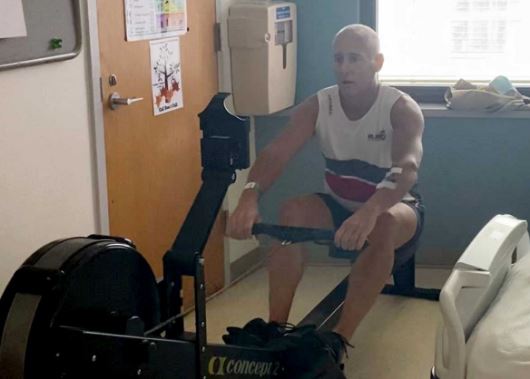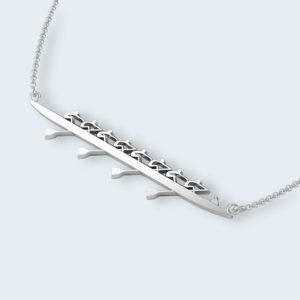Are you a rower looking to improve your performance? Maybe the recent lockdown has made it difficult for you to get out on the water? Or perhaps you’ve been training for a few years and you feel like there’s something missing from your rowing game plan?
Have you considered adding strength and conditioning training sessions to your routine? In doing so, you’ll be able to improve your strength, exert more force with each stroke, and get your split times way more competitive.
In this article, we’ll be looking at some of the major benefits of strength training for rowers, some of the best exercises that you can use, and how to work them into a periodised training plan.
Strength and Conditioning Practices: Land vs On Water
On the water, the coach is boss; you’re part of a team so you need to stick to the overall game plan that your coach has set up for you. If you’ve been asked to do lots of longer endurance work, do it. If you’ve been asked to do lots of faster-paced work, then do that. This will depend largely on your goals and what you are training for. Even without a coach, rowers training regimen on the water is usually pretty solid.
On land, though, you may not be so structured in how you approach your training or know what to focus on away from the water. Focusing on strength and conditioning gives you the opportunity to not only increase physical performance but also gives you space to personalise your training in order to tackle your own weaknesses or areas where you may be lagging.
Strength Training for Rowing Performance: Benefits and Training Goal
Intra-muscular Co-ordination
Out on the water, all your technique training builds inter-muscular coordination, the ability of various different muscles to coordinate their contractions. With strength training, you’ll be building intra-muscular coordination, the ability of a single muscle to coordinate the firing of its muscle fibres and produce more force. (Young 2006)
Strength Endurance
Coach Patrick from startrowing.com had this to say about sport endurance: Rowing is a sport in which you need to use your strength for a long amount of time (6-7 minutes for most 2k’s) Luckily, developing your top end strength also leads to improvements in your strength endurance. Think of it this way, if you were so strong that every stroke felt like pulling through the air, how much faster do you think you would be?
Core Training
A solid core (hips, lower back and torso) allows for far better transfer of force throughout your body (Shinkle et al. 2012) This means that every bit of work your legs and back do gets put to much better use. A good way to think about this is to imagine towing a car. Do you think it would be better to pull the car using a rope that was tight and strong, or a rope that was soft and wobbly?
Is Strength Training Always Suitable: Applications for Rowers
The primary training goal will always be to increase rowing performance. This means that strength training will be applied as a secondary training method. Any work performed during these sessions should not inhibit rowing performance.
This means that we must apply suitable training principles for our strength training. Workouts should be kept at a high intensity with a low duration and low training frequency to maximise the work done and reduce levels of fatigue.
That being said, the same type and amount of training may not be suitable for all rowers. This does not mean that strength training should be excluded altogether, but that it must be adapted to suit the individual needs of the athlete.
Lightweight Rowers
Lightweight rowers are often worried about gaining too much muscle and becoming too heavy. This is very unlikely to happen unless your diet changes dramatically to a point where you are in a large calorie surplus. Since your strength training will mainly consist of compound and explosive exercises that use low reps you can actually get a lot stronger without adding much extra size.
Women
Strength training is incredibly useful for female rowers for all of the reasons we discussed above. There are literally no drawbacks or differences from men performing the same of similar training.
Juniors
Strength training is perfectly safe for junior rowers and will improve their performance just like their adult counterparts. The main thing to remember is to encourage good form and allow plenty of time for recovery in between sessions. (Benjamin and Glow 2003, Faigenbaum 2016)
Just to note, the overall training volume should be reduced for juniors.
Example Strength Exercises for Rowing
The 2 most important muscle groups to focus on for rowers will be your legs and your back. Specifically, you want to focus on pushing type leg movements and horizontal pulling type back movements. Here are a couple of recommendations…
- Leg Strength: Back Squats
- Leg Strength: Leg Press Machine
- Back Strength: Bent-Over Rows
- Back Strength: Seated Row Machine
You will also benefit from movements that involve hip hinging to strengthen your lower back and hamstrings, a great example is…
- Lower Back & Hamstring Strength: Romanian Deadlift
Last but not least, rowers will benefit from specific core strength exercises. Two good examples include…
- Core Strength: Planks
- Core Strength: Side Planks
For all the leg and back strength movements, the famous 5 sets of 5 reps is a fantastic place to start. For the core movements, use a timer and aim to beat your score each week.
Applying Periodised Strength Training to Your Program
Periodisation is a term that sounds complicated, but actually just describes the selective variation of training stimulus over time. The amount of periodisation required within a programme mainly depends on the training level of the athlete.
If you’re completely new to strength training, the only periodisation you need is a slight increase in weight every session. For example, if you squatted 50kg in today’s session for all your required repetitions you’ll squat 52.5kg in your next session.
On the other hand, if you’ve been strength training for many years and now squat 200kg you won’t be able to progress every session anymore. You might need to have a training programme that builds up over 12 weeks in order to make more progress.
In the second example, strength training may also be intense enough to interfere with your rowing training, so you’ll have to consider timing your hardest strength training to coincide with your off-season.
Conclusion
At this point, you should know the major benefits of strength training for rowing performance, as well as some of the most effective strength exercises that you can use as part of your programme. You also know that the style and amount of periodisation to use depends on your own training level.
Your best course of action is to get to find/create a program to follow and get started. Your movements don’t have to be perfect; it will be a learning process. After a few weeks/months, though, you’ll start to see some significant improvements not only in your athleticism but also in your rowing times.
Note: This is a guest post written by Liam Coultman. The materials on this post comprise the authors view. They do not constitute legal or professional advise. Rowperfect is not responsible for the content and any linked site.
References
Benjamin, H. & Glow, K. (2003) Strength Training for Children and Adolescents, The Physician and Sports medicine, 31:9, 19-26
Faigenbaum, A., McFarland, J. (2016) Resistance Training for Kids, ACSM’s Health & Fitness Journal: September/October; Volume 20, Issue 5,16-22
Shinkle et al. (2012) Effect of Core Strength on the Measure of Power in the Extremities, Journal of Strength and Conditioning Research: Volume 26 – Issue 2 – p 373-380
Young, W. B. (2006). Transfer of Strength and Power Training to Sports Performance, International Journal of Sports Physiology and Performance, 1(2), 74-83.







